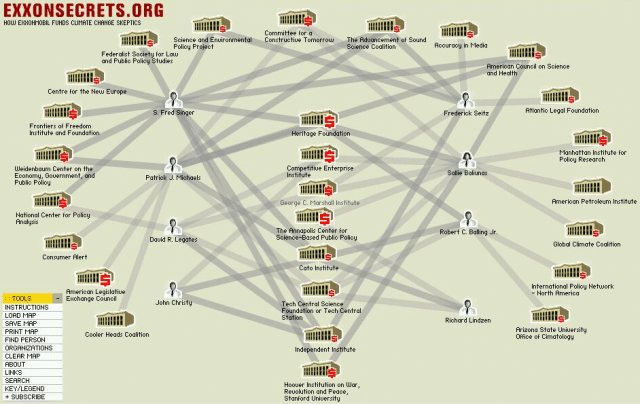Greenpeace released a terrific report today on the 20-year campaign by polluters to mislead the public by creating the climate denial industry.
The new report succinctly explains how fossil fuel interests used the tobacco industry’s playbook and an extensive arsenal of lobbyists and “experts” for hire in order to manufacture disinformation designed to confuse the public and stifle action to address climate change.
In the report, titled “Dealing in Doubt: The Climate Denial Industry and Climate Science,” Greenpeace provides a brief history of the attacks waged by polluting industries against climate science, the IPCC and individual scientists.
ExxonMobil deservedly gets special attention for its role as the ringleader of the “campaign of denial.” As Greenpeace has documented meticulously over the years with its ExxonSecrets website, ExxonMobil is known to have invested over $23 million since 1998 to bankroll an entire movement of climate confusionists, including over 35 anti-science and right wing nonprofits, to divert attention away from the critical threat of climate disruption caused largely by the burning of fossil fuels.
The report, authored by Greenpeace climate campaigner Cindy Baxter, calls out by name a number of key climate skeptics and deniers who have worked with industry front groups to confuse the public, including S. Fred Singer, John Christy, Richard Lindzen, David Legates, Sallie Baliunas, Willie Soon, Tim Ball, Pat Michaels and many other figures familiar to DeSmog Blog readers.
A number of the key “think tanks” at the forefront of the attacks on climate science – including the Heartland Institute, Competitive Enterprise Institute, American Enterprise Institute, George C. Marshall Institute, Heritage Foundation and Cato Institute – are also examined for their climate denial work on behalf of oil and coal interests.
Greenpeace explains how the network of denial was created in the early 1990s to dissuade politicians from taking action to prevent climate change. Chief among these early groups were the Global Climate Coalition, the Climate Council and the Information Council on the Environment (ICE).
The report also provides a brief history of the attacks launched against each of the IPCC’s scientific assessment reports dating back to 1990, noting the key players involved in each successive attack leading up to the present day attempts to tarnish the IPCC’s reputation and to falsely suggest that a debate still exists among climate scientists.
Personal attacks endured by climate scientists, especially key contributors to the IPCC reports, are also discussed in some detail, including the virulent attacks by the climate denial industry against reputed scientists like Michael Mann, Ben Santer, and Kevin Trenberth.
Greenpeace also calls out Senator James Inhofe (R-OK) and other members of Congress who are beholden to polluting industries through campaign contributions, and who regularly aid and abet the climate denial industry by promoting the false and misleading claims of deniers and skeptics on Capitol Hill.
Finally, “Dealing in Doubt” notes the escalation of the denial campaign during the administration of George W. Bush, when key White House and regulatory agency positions were filled with polluter lobbyists.
The placement of Philip Cooney, a lawyer and lobbyist who spent 15 years at the American Petroleum Institute before he was picked as chief of staff in the Bush White House Council on Environmental Quality, serves as a key example. Days after the New York Times broke the story that Cooney had made extensive edits on government scientific reports on global warming, Cooney resigned to go work for ExxonMobil.
“Dealing in Doubt” is recommended reading for anyone looking for a brief primer on the history of the denial industry’s relentless campaign against science and reason. It should be required reading for members of Congress, the mainstream media, and others who continue to be duped by the climate denial industry.
Subscribe to our newsletter
Stay up to date with DeSmog news and alerts






